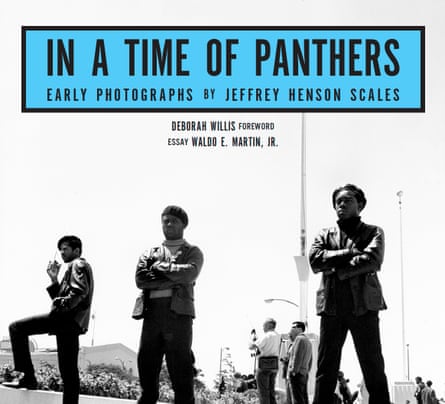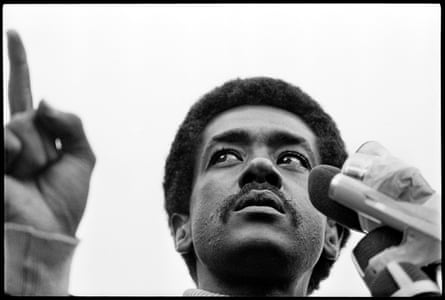[ad_1]
Jeffrey Henson Scales is a New York Times photo editor. His latest book is most compelling in how it helps place the relentless quest for equal treatment in easily understood context. Beyond beauty or mere appealing images, In a Time of Panthers is a highly valuable work.
Characterizing the Black Panther movement as “the vanguard of the African American civil rights struggle”, Henson Scales shows how it emerged. The movement became “focused on police violence and community needs in over-policed and under-served communities of color”. To Henson Scales, “So much in all of our lives would continue to change in ways unforeseen to me … so many of the issues that motivated us during these inspired years of activism in America remain unresolved.”
For sure, the scourge of urban crime is still hotly debated. The writer Adam Gopnik once remarked that so long as you promise to keep them safe, even in Manhattan, the white middle-class is “pretty much content to look away when the rights of others are being violated”.
This, according to a Bronx politician who spoke on condition of anonymity, “is why New York state’s recently hard-won amelioration of bad police policy is threatened now”. Jeff Mays, a Times reporter who lives in Harlem, concurred. He observed the irony of how closely the new Democratic mayor, Eric Adams, echoed the Republican gubernatorial candidate Lee Zeldin, a Trump supporter. Repeatedly, as hard as he could, Zeldin hit Governor Kathy Hochul with the upsurge in crime attendant to the Covid pandemic. Though making their other differences clear, Mays said of Adams and Zeldin: “Certainly their rhetoric has been very similar on things like bail reform.”

Changing discriminatory bail laws, an historic accomplishment meant to equalize justice, was hardly easy. In reaction to Black Lives Matter activists, responding to a rash of police murders, progressive leaders sought to finally fix one of the many issues raised by the Panthers.
“Even with it taking until now to address, there’s pushback,” said the Bronx official. . “Some seem eager to retreat to where we were. Man that’s a pitiful shame! And, without a shred of evidence, Adams connecting crime to the bail law – that was just short of a Willie Horton ad. And for Democrats, in the most enlightened place there is, New York, it was just as destructive too.”
To Henson Scales, crime is complicated.
“It requires nuanced thinking,” he maintains. Yes, today’s increase of violent crime is still “only” producing a few hundred annual homicides, versus a few thousand in the smaller city of 1990. “But with many, many more guns, with magazines capable of cutting down hundreds of victims in seconds, sometimes I do feel as unsafe as I did in the 1990s.”
He cautions: “It’s imperative not to overreact and at all cost to avoid unintended consequences, like the mass incarceration that accompanied the Rockefeller drug laws [of 1973]. Black preachers and politicians, thousands of African Americans, favored and voted for such laws. But look where they led.”
How did Henson Scales come to produce his book, which morphed into an exhibition associated with Art Basel, on display in Miami’s Black Overtown neighborhood, across from the Red Rooster Restaurant?

“Well,” he said, “Four years ago, not long after my mother’s death, my family was preparing our house for sale. It’s a cool place, big enough to have a ballroom and a darkroom too. In one spot they discovered this stash of 40 rolls of film. They reasoned it was mine. And it was. I was so glad they were not lost.
“This stuff dated from the late-1960s. I was around 14, a high-school freshman. My dad was a hobbyist photographer and my mother was a painter. Even before I turned 11, when dad gave me a Leica camera, both patiently instructed me. That earliest footage of mine contained a mixed bag of images. There were people and places I hoped to remember. I photographed protest and riots in my home city of Berkeley, California. Sly and the Family Stone and other acts that appeared at the Fillmore, across the bay in San Francisco, were represented too. And then among it all, was this cache of 15 sleeves with negatives showing various aspects of the Black Panther Party for Self Defense. The two of us, we grew up together.”
Oakland and Berkeley, Haight-Ashbury, the Castro, LA, the summer of love, women’s liberation, Vietnam, uprisings in urban ghettos.
“They were,” recalls Scales, “all of a piece. But the Panthers were the coolest people.”
He seems caught up in the dynamic of art utilized in the service of action and change, taking note of great style.

“The whole presentation with the leather jackets, the berets. They were very cool. You had the hippies … and then you had the Black Panthers … and it was very powerful … The movement was feeling like we could change society. We could have an effect. It was a very exciting place to be. It was dangerous because of police violence against the Panthers … As a teenager that’s all very exciting because you’re not that concerned with safety like you are as you get older.”
In discussion, Henson Scales squarely addressed this short-lived Black empowerment movement’s flaws, its misogyny, homophobia, infighting and FBI infiltration. By contrast, his book is more a testament to the group’s strides in overcoming such drawbacks. In pursuit of recognition, handsome Huey P Newton, the Panther’s minister of defense and co-founder, stressed the value of alliances among all oppressed outcasts:
Whatever your personal opinions and your insecurities about homosexuality and the various liberation movements among homosexuals and women (and I speak of the homosexuals and women as oppressed groups), we should try to unite with them in a revolutionary fashion. I say ‘whatever your insecurities are’ because as we very well know, sometimes our first instinct is to want to hit a homosexual in the mouth, and want a woman to be quiet. We want to hit a homosexual in the mouth because we are afraid that we might be homosexual; and we want to hit the women or shut her up because we are afraid that she might castrate us, or take the nuts that we might not have to start with.”
Coming to boast a membership of more than 10,000, 50% of whom were women, the Panther party shone a spotlight on police and political corruption, brutality and injustice, a story also related in a film by an early Panthers member, Henson Scales’s Harlem neighbor Stanley Nelson.

The Black Panthers: Vanguard of the Revolution debuted in 2015. It elaborates on the party’s wide-ranging social programs. They established community support systems including food and clothing banks, clinics, transport for families of inmates, legal seminars. In the 70s the Panther’s Free Breakfast for Children, nationwide, fed thousands. All this was achieved amid near-constant surveillance by police and J Edgar Hoover of the FBI, who demonized the BPP as “the greatest internal threat to national security”.
Rather than giving a daily rundown of all they did and didn’t do, Henson Scales’ portrayals show these revolutionaries as part of the pantheon of Black valor.
When Viola Davis’s recent film The Woman King appeared, many critics were astonished. Projected to gross around $12m in its opening week, it grossed $19.05m. Worldwide, the “history-based” epic has earned nearly $100m. A similarly misunderstood historical fantasy, the astutely named, Black Panther: Wakanda Forever, has earned more than three times that.
As history, both are unashamedly inventive and melodramatic – much like Shakespeare. The “African-inspired” costuming and architecture is highly inauthentic. Heavy reliance on spectacle is akin to Braveheart or Gladiator. Resoundingly praised performances notwithstanding, some have wondered aloud about the appeal of such movies to Black people.

If African American motivations and culture seem inscrutable to many, they ought not. Only now are we both able and fully prepared to embrace our heritage.
In a Time of Panthers is an arresting look at some mighty heroes from the recent past. We revere them along with never-enslaved Blacks and those held in captivity. We celebrate our ancestors and adhere to Neo-Africanism. Whether such sources are accurately drawn or totally fabricated, the inspiration we take is legitimate. This is today’s aesthetic and intellectual answer to white supremacy’s neo-classical domination: a realization that we too are the heirs of greatness.
[ad_2]